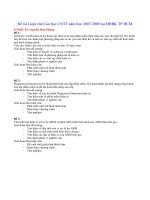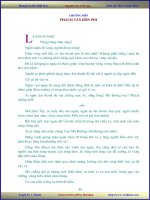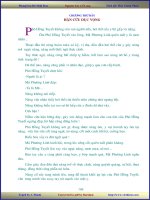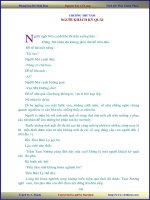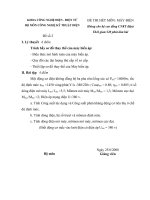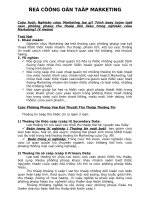Tài liệu Đề tài " Minimal p-divisible groups " docx
Bạn đang xem bản rút gọn của tài liệu. Xem và tải ngay bản đầy đủ của tài liệu tại đây (392.03 KB, 17 trang )
Annals of Mathematics
Minimal p-divisible
groups
By Frans Oort
Annals of Mathematics, 161 (2005), 1021–1036
Minimal p-divisible groups
By Frans Oort
Introduction
A p-divisible group X can be seen as a tower of building blocks, each of
which is isomorphic to the same finite group scheme X[p]. Clearly, if X
1
and
X
2
are isomorphic then X
1
[p]
∼
=
X
2
[p]; however, conversely X
1
[p]
∼
=
X
2
[p]does
in general not imply that X
1
and X
2
are isomorphic. Can we give, over an
algebraically closed field in characteristic p, a condition on the p-kernels which
ensures this converse? Here are two known examples of such a condition:
consider the case that X is ordinary, or the case that X is superspecial (X
is the p-divisible group of a product of supersingular elliptic curves); in these
cases the p-kernel uniquely determines X.
These are special cases of a surprisingly complete and simple answer:
If G is “minimal ”, then X
1
[p]
∼
=
G
∼
=
X
2
[p] implies X
1
∼
=
X
2
;
see (1.2); for a definition of “minimal” see (1.1). This is “necessary and
sufficient” in the sense that for any G that is not minimal there exist in-
finitely many mutually nonisomorphic p-divisible groups with p-kernel isomor-
phic to G; see (4.1).
Remark (motivation). You might wonder why this is interesting.
EO. In [7] we defined a natural stratification of the moduli space of polar-
ized abelian varieties in positive characteristic: moduli points are in the
same stratum if and only if the corresponding p-kernels are geometrically
isomorphic. Such strata are called EO-strata.
Fol. In [8] we define in the same moduli spaces a foliation: Moduli points are
in the same leaf if and only if the corresponding p-divisible groups are
geometrically isomorphic; in this way we obtain a foliation of every open
Newton polygon stratum.
Fol ⊂ EO. The observation X
∼
=
Y ⇒ X[p]
∼
=
Y [p] shows that any leaf in the
second sense is contained in precisely one stratum in the first sense; the
main result of this paper, “X is minimal if and only if X[p] is minimal”,
1022 FRANS OORT
shows that a stratum (in the first sense) andaleaf(in the second sense)
are equal in the minimal, principally polarized situation.
In this paper we consider p-divisible groups and finite group schemes over
an algebraically closed field k of characteristic p.
An apology. In (2.5) and in (3.5) we fix notation, used for the proof
of (2.2), respectively (3.1); according to the need, the notation in these two
different cases is different. We hope this difference in notation in Section 2
versus Section 3 will not cause confusion.
Group schemes considered are supposed to be commutative. We use co-
variant Dieudonn´e module theory and write W = W
∞
(k) for the ring of in-
finite Witt vectors with coordinates in k. Finite products in the category of
W -modules are denoted “×”orby“
”, while finite products in the category
of Dieudonn´e modules are denoted by “⊕”; for finite products of p-divisible
groups we use “×”or“
”. We write F and V , as usual, for “Frobenius”
and “Verschiebung” on commutative group schemes and let F = D(V) and
V = D(F); see [7, 15.3], for the corresponding operations on Dieudonn´emod-
ules.
Acknowledgments. Part of the work for this paper was done while vis-
iting Universit´e de Rennes, and the Massachusetts Institute of Technology; I
thank the Mathematics Departments of these universities for hospitality and
stimulating working environment. I thank Bas Edixhoven and Johan de Jong
for discussions on ideas necessary for this paper. I thank the referee for helpful,
critical remarks.
1. Notation and the main result
(1.1) Definitions and notation.
H
m,n
. We define the p-divisible group H
m,n
over the prime field F
p
in
case m and n are coprime nonnegative integers; see [2, 5.2]. This p-divisible
group H
m,n
is of dimension m, its Serre-dual X
t
is of dimension n, it is isosim-
ple, and its endomorphism ring End(H
m,n
⊗ F
p
) is the maximal order in the
endomorphism algebra End
0
(H
m,n
⊗F
p
) (and these properties characterize this
p-divisible group over
F
p
). We will use the notation H
m,n
over any base S in
characteristic p; i.e., we write H
m,n
instead of H
m,n
×
Spec(
F
p
)
S, if no confusion
can occur.
The ring End(H
m,n
⊗ F
p
)=R
is commutative; write L for the field
of fractions of R
. Consider integers x, y such that for the coprime positive
integers m and n we have x·m + y·n =1. InL we define the element π =
F
y
·V
x
∈ L. Write h = m + n. Note that π
h
= p in L. Here R
⊂ L is the
maximal order; hence R
is integrally closed in L, and we conclude that π ∈ R
.
MINIMAL p -DIVISIBLE GROUPS
1023
This element π will be called the uniformizer in this endomorphism ring. In
fact, W
∞
(F
p
)=Z
p
, and R
∼
=
Z
p
[π]. In L we have:
m + n =: h, π
h
= p, F = π
n
, V = π
m
.
For a further description of π,ofR = End(H
m,n
⊗ k) and of D = End
0
(H
m,n
⊗ k), see [2, 5.4]; note that End
0
(H
m,n
⊗ k) is noncommutative if m>0 and
n>0. Note that R is a “discrete valuation ring” (terminology sometimes also
used for noncommutative rings).
Newton polygons. Let β be a Newton polygon. By definition, in the
notation used here, this is a lower convex polygon in R
2
starting at (0, 0),
ending at (h, c) and having break points with integral coordinates; it is given by
h slopes in nondecreasing order; every slope λ is a rational number, 0 ≤ λ ≤ 1.
To each ordered pair of nonnegative integers (m, n) we assign a set of
m + n = h slopes equal to n/(m + n); this Newton polygon ends at (h, c = n).
In this way a Newton polygon corresponds with a set of ordered pairs; such
a set we denote symbolically by
i
(m
i
,n
i
); conversely such a set determines
a Newton polygon. Usually we consider only coprime pairs (m
i
,n
i
); we write
H(β):=×
i
H
m
i
,n
i
in case β =
i
(m
i
,n
i
). A p-divisible group X over a
field of positive characteristic defines a Newton polygon where h is the height
of X and c is the dimension of its Serre-dual X
t
. By the Dieudonn´e-Manin
classification, see [5, Th. 2.1, p. 32], we know: Two p-divisible groups over an
algebraically closed field of positive characteristic are isogenous if and only if
their Newton polygons are equal.
Definition.Ap-divisible group X is called minimal if there exists a New-
ton polygon β and an isomorphism X
k
∼
=
H(β)
k
, where k is an algebraically
closed field.
Note that in every isogeny class of p-divisible groups over an algebraically
closed field there is precisely one minimal p-divisible group.
Truncated p-divisible groups. A finite group scheme G (finite and flat
over some base, but in this paper we will soon work over a field) is called a
BT
1
, see [1, p. 152], if G[F] := KerF
G
=ImV
G
=: V(G) and G[V]=F(G) (in
particular this implies that G is annihilated by p). Such group schemes over
a perfect field appear as the p-kernel of a p-divisible group, see [1, Prop. 1.7,
p. 155]. The abbreviation “BT
1
” stand for “1-truncated Barsotti-Tate group”;
the terms “p-divisible group” and “Barsotti-Tate group” indicate the same
concept.
The Dieudonn´e module of a BT
1
over a perfect field K is called a DM
1
; for
G = X[p]wehaveD(G)=D(X)/pD(X). In other terms: such a Dieudonn´e
module M
1
= D(X[p]) is a finite dimensional vector space over K, on which
1024 FRANS OORT
F and V operate (with the usual relations), with the property that M
1
[V]=
F¸(M
1
) and M
1
[F]=V¸(M
1
).
Definition. Let G beaBT
1
group scheme; we say that G is minimal if
there exists a Newton polygon β such that G
k
∼
=
H(β)[p]
k
.ADM
1
is called
minimal if it is the Dieudonn´e module of a minimal BT
1
.
(1.2) Theorem. Let X be a p-divisible group over an algebraically closed
field k of characteristic p.Letβ be a Newton polygon. Then
X[p]
∼
=
H(β)[p]=⇒ X
∼
=
H(β).
In particular : if X
1
and X
2
are p-divisible groups over k, with X
1
[p]
∼
=
G
∼
=
X
2
[p], where G is minimal, then X
1
∼
=
X
2
.
Remark. We have no a priori condition on the Newton polygon of X,
nor do we a priori assume that X
1
and X
2
have the same Newton polygon.
Remark. In general an isomorphism ϕ
1
: X[p] → H(β)[p] does not lift to
an isomorphism ϕ : X → H(β).
(1.3) Here is another way of explaining the result of this paper. Consider
the map
[p]:{X | a p-divisible group}/
∼
=
k
−→ { G | aBT
1
}/
∼
=
k
,X→ X[p].
This map is surjective; e.g., see [1, 1.7]; also see [7, 9.10].
• By results of this paper we know: For every Newton polygon β there
is an isomorphism class X := H(β) such that the fiber of the map [p]
containing X consists of one element.
• For every X not isomorphic to some H(β) the fiber of [p] containing X
is infinite; see (4.1)
Convention. The slope λ = 0, given by the pair (1, 0), defines the
p-divisible group G
1,0
= G
m
[p
∞
], and its p-kernel is µ
p
. The slope λ =1,
given by the pair (0, 1), defines the p-divisible group G
0,1
= Q
p
/Z
p
and its
p-kernel is Z/pZ
. These p-divisible groups and their p-kernels split off natu-
rally over a perfect field; see [6, 2.14]. The theorem is obvious for these minimal
BT
1
group schemes over an algebraically closed field. Hence it suffices to prove
the theorem in case all group schemes considered are of local-local type, i.e.
all slopes considered are strictly between 0 and 1; from now on we make this
assumption.
MINIMAL p -DIVISIBLE GROUPS
1025
(1.4) We give now one explanation about notation and method of proof.
Let m, n ∈ Z
>0
be coprime. Start with H
m,n
over F
p
. Let Q
= D(H
m,n
⊗ F
p
).
In the terminology of [2, 5.6 and §6], a semi-module of H
m,n
equals [0, ∞)=
Z
≥0
. Choose a nonzero element in Q
/πQ
; this is a one-dimensional vector
space over F
p
, and lift this element to A
0
∈ Q
. Write A
i
= π
i
A
0
for every
i ∈ Z
>0
. Note that
πA
i
= A
i+1
, FA
i
= A
i+n
, VA
i
= A
i+m
.
Fix an algebraically closed field k; we write Q = D(H
m,n
⊗ k). Clearly
A
i
∈ Q
⊂ Q, and the same relations as given above hold. Note that
{A
i
| i ∈ Z
≥0
} generate Q as a W -module. The fact that a semi-module
of the minimal p-divisible group H
m,n
does not contain “gaps” is the essential
(but sometimes hidden) argument in the proofs below.
The set {A
0
, ,A
m+n−1
} is a W -basis for Q.Ifm ≥ n we see that
{A
0
, ,A
n−1
} is a set of generators for Q as a Dieudonn´e module; the struc-
ture of this Dieudonn´e module can be described as follows: For this set of
generators we consider another numbering {C
1
, ,C
n
} = {A
0
, ,A
n−1
} and
define positive integers γ
i
by C
1
= A
0
and F
γ
1
C
1
= VC
2
, ,F
γ
n
C
n
= VC
1
(note that we assume m ≥ n), which gives a “cyclic” set of generators for
Q/pQ in the sense of [3]. This notation will be repeated and explained more
in detail in (2.5) and (3.5).
2. A slope filtration
(2.1) We consider a Newton polygon β given by r
1
(m
1
,n
1
), ,r
t
(m
t
,n
t
);
here r
1
, ,r
t
∈ Z
>0
, and every (m
j
,n
j
) is an ordered pair of coprime positive
integers; we write h
j
= m
j
+ n
j
and suppose the ordering is chosen in such a
way that λ
1
:= n
1
/h
1
< ···<λ
t
:= n
t
/h
t
.Now,
H := H(β)=
1≤j≤t
(H
m
j
,n
j
)
r
j
; G := H(β)[p].
The following proposition uses this notation; suppose that t>0.
(2.2) Proposition. Suppose X is a p-divisible group over an algebraically
closed field k, that X[p]
∼
=
H(β)[p], and that λ
1
= n
1
/h
1
≤ 1/2. Then there
exists a p-divisible subgroup X
1
⊂ X and isomorphisms
X
1
∼
=
(H
m
1
,n
1
)
r
1
and (X/X
1
)[p]
∼
=
j>1
(H
m
j
,n
j
[p])
r
j
.
(2.3) Remark. The condition that X[p]isminimal is essential; e.g. it is
easy to give an example of a p-divisible group X which is isosimple, such that
X[p] is decomposable; see [9].
1026 FRANS OORT
(2.4) Corollary. For X with X[p]
∼
=
H(β)[p], with β as in (2.1), there
exists a filtration by p-divisible subgroups
X
0
:= 0 ⊂ X
1
⊂···⊂X
t
= X
such that
X
j
/X
j−1
∼
=
(H
m
j
,n
j
)
r
j
,
for 1 ≤ j ≤ t.
Proof of the corollary. Assume by induction that the result has been
proved for all p-divisible groups where Y [p]=H(β
)[p] is minimal such that β
has at most t − 1 different slopes; induction starting at t − 1 = 0, i.e. Y =0. If
on the one hand the smallest slope of X is at most 1/2, the proposition gives
0 ⊂ X
1
⊂ X, and using the induction hypothesis on Y = X/X
1
we derive
the desired filtration. If on the other hand all slopes of X are bigger than
1/2, we apply the proposition to the Serre-dual of X, using the fact that the
Serre-dual of H
m,n
is H
n,m
; dualizing back we obtain 0 ⊂ X
t−1
⊂ X, and using
the induction hypothesis on Y = X
t−1
we derive the desired filtration. Hence
we see that the proposition gives the induction step; this proves the corollary.
(2.2)⇒(2.4)
(2.5) We use notation as in (2.1) and (2.2), and fix further notation which
will be used in the proof of (2.2). Let M = D(X). We write Q
j
= D(H
m
j
,n
j
).
Hence
M/pM
∼
=
1≤j≤t
(Q
j
/pQ
j
)
r
j
.
Using this isomorphism we construct a map
v : M −→ Q
≥0
∪ {∞}.
We use notation as in (1.1) and in (1.4). Let π
j
be the uniformizer of
End(Q
j
). We choose A
(j)
i,s
∈ Q
j
with i ∈ Z
≥0
and 1 ≤ s ≤ r
j
(which gener-
ate Q
j
) such that π
j
·A
(j)
i,s
= A
(j)
i+1,s
, F·A
(j)
i,s
= A
(j)
i+n
j
,s
and V·A
(j)
i,s
= A
(j)
i+m
j
,s
.
Now, Q
j
/pQ
j
= ×
0≤i<h
j
k·(A
(j)
i,s
mod pQ
j
) and
A
(j)
i
=(A
(j)
i,s
| 1 ≤ s ≤ r
j
) ∈ (Q
j
)
r
j
for the vector with coordinate A
(j)
i,s
in the summand on the s
th
place.
For B ∈ M we uniquely write
B mod pM = a =
j, 0≤i<h
j
, 1≤s≤r
j
b
(j)
i,s
·(A
(j)
i,s
mod pQ
j
),b
(j)
i,s
∈ k;
MINIMAL p -DIVISIBLE GROUPS
1027
if moreover B ∈ pM we define
v(B) = min
j, i, s, b
(j)
i,s
=0
i
h
j
.
If B
∈ p
β
M and B
∈ p
β+1
M we define v(B
)=β + v(p
−β
·B
) and then write
v(0) = ∞. This ends the construction of v : M −→ Q
≥0
∪ {∞}.
For any ρ ∈ Q we define
M
ρ
= {B | v(B) ≥ ρ};
note that pM
ρ
⊂ M
ρ+1
. Let T be the least common multiple of h
1
, , h
t
.
Note that, in fact, v : M −{0}→
1
T
Z
≥0
and that, by construction, v(B) ≥
d ∈ Z if and only if p
d
divides B in M. Hence ∩
ρ→∞
M
ρ
= {0}.
The basic assumption X[p]
∼
=
H(β)[p] of (1.2) is:
M/pM =
1≤j≤t, 1≤s≤r
j
0≤i<h
j
k·((A
(j)
i,s
mod pQ
j
))
(we write this isomorphism of Dieudonn´e modules as an equality). For 0 ≤ i
<h
j
and 1 ≤ s ≤ r
j
we choose B
(j)
i,s
∈ M such that:
B
(j)
i,s
mod pM = A
(j)
i,s
mod pQ
r
j
j
.
Define B
(j)
i+β·h
j
,s
= p
β
·B
(j)
i,s
. By construction we have: v(B
(j)
i,s
)=i/h
j
for all
i ≥ 0, all j and all s. Note that M
ρ
is generated over W = W
∞
(k)byall
elements B
(j)
i,s
with v(B
(j)
i,s
) ≥ ρ. Using shorthand we write
B
(j)
i
for the vector (B
(j)
i,s
| 1 ≤ s ≤ r
j
) ∈ M
r
j
.
Next, P ⊂ M for the sub-W-module generated by all B
(j)
i,s
with j ≥ 2 and
i<h
j
; also, N ⊂ M for the sub-W -module generated by all B
(1)
i,s
with i<h
1
.
Note that M = N × P , a direct sum of W -modules and that M
ρ
=(N ∩ M
ρ
) ×
(P ∩ M
ρ
).
In the proof the W -submodule P ⊂ M will be fixed; its W -complement
N ⊂ M will change eventually if it is not already a Dieudonn´e submodule.
We write m
1
= m, n
1
= n, h = h
1
= m + n, and r = r
1
. Note that we
assumed 0 <λ
1
≤ 1/2; hence m ≥ n>0. For i ≥ 0 we define integers δ
i
by:
i·h ≤ δ
i
·n<i·m +(i +1)·n = ih + n.
Also, there are nonnegative integers γ
i
such that
δ
0
=0,δ
1
= γ
1
+1, , δ
i
= γ
1
+1+γ
2
+1+···+ γ
i
+1, ;
note that δ
n
= h = m + n; hence γ
1
+ ···+ γ
n
= m. For 1 ≤ i ≤ n we write
f(i)=δ
i−1
·n − (i − 1)·h;
1028 FRANS OORT
this means that 0 ≤ f(i) <nis the remainder after dividing δ
i−1
n by h; note
that f(1) = 0. As gcd(n, h) = 1 we see that
f : {1, ,n}→{0, ,n− 1}
is a bijective map. The inverse map f
is given by:
f
: {0, ,n− 1}→{1, ,n},f
(x) ≡ 1 −
x
h
(mod n), 1 ≤ f
(x) ≤ n.
In (Q
1
)
r
we have the vectors A
(1)
i
. We choose C
1
:= A
(1)
0
and we choose
{C
1
, ,C
n
} = {A
(1)
0
, ,A
(1)
n−1
} by
C
i
:= A
(1)
f(i)
,C
f
(x)
= A
(1)
x
;
this means that:
F
γ
i
C
i
= VC
i+1
, 1 ≤ i<n, F
γ
n
C
n
= VC
1
;
hence
F
δ
i
C
1
= p
i
·C
i+1
, 1 ≤ i<n.
Note that F
h
C
1
= p
n
·C
1
. With these choices we see that
{F
j
C
i
| 1 ≤ i ≤ n, 0 ≤ j ≤ γ
i
} = {A
(1)
| 0 ≤ <h}.
For later reference we state:
(2.6) Suppose Q is a nonzero Dieudonn´e module with an element C ∈ Q,
such that there exist coprime integers n and n + m = h as above such that
F
h
·C = p
n
·C and such that Q, as a W -module, is generated by {p
−[jn/h]
F
j
C |
0 ≤ j<h}, then Q
∼
=
D(H
m,n
).
This is proved by explicitly writing out the required isomorphism. Note
that F
n
is injective on Q; hence F
h
·C = p
n
·C implies F
m
·C = V
n
·C.
(2.7) Accordingly we choose C
i,s
:= B
(1)
f(i),s
∈ M with 1 ≤ i ≤ n. Note
that
{F
j
C
i,s
| 1 ≤ i ≤ n, 0 ≤ j ≤ γ
i
, 1 ≤ s ≤ r} is a W -basis for N,
F
γ
i
C
i,s
−VC
i+1,s
∈ pM, 1 ≤ i<n, F
γ
n
C
n,s
−VC
1,s
∈ pM.
We write C
i
=(C
i,s
| 1 ≤ s ≤ r). As a reminder, we sum up some of the
notation constructed:
N ⊂ M
j
(Q
j
)
r
j
M/pM =
j
(Q
j
/pQ
j
)
r
j
,
B
(j)
i,s
∈ M, A
(j)
i,s
∈ Q
j
⊂ (Q
j
)
r
j
,
C
i,s
∈ N, C
i,s
∈ Q
1
⊂ (Q
1
)
r
1
.
MINIMAL p -DIVISIBLE GROUPS
1029
(2.8) Lemma. Use the notation fixed up to now.
(1) For every ρ ∈ Q
≥0
the map p : M
ρ
→ M
ρ+1
, multiplication by p, is
surjective.
(2) For every ρ ∈ Q
≥0
there exists FM
ρ
⊂ M
ρ+(n/h)
.
(3) For every i and s, FB
(1)
i,s
∈ M
(i+n)/h
; for every i and s and every j>1,
FB
(j)
i,s
∈ M
(i/h
j
)+(n/h)+(1/T )
.
(4) For every 1 ≤ i ≤ n there is F
δ
i
C
1
− p
i
B
(1)
f(i+1)
∈ (M
i+(1/T )
)
r
; moreover
F
δ
n
C
1
− p
n
C
1
∈ (M
n+(1/T )
)
r
.
(5) If u is an integer with u>Tn, and ξ
N
∈ (N ∩ M
u/T
)
r
, there exists
η
N
∈ N ∩ (M
(u/T )−n
)
r
such that
(F
h
− p
n
)η
N
≡ ξ
N
(mod (M
(u+1)/T
)
r
).
Proof. We know that M
ρ+1
is generated by the elements B
(j)
i,s
with i/h
j
≥
ρ + 1; because ρ ≥ 0 such elements satisfy i ≥ h
j
. Note that p·B
(j)
i−h
j
,s
= B
(j)
i,s
.
This proves the first property. ✷(1)
At first we show FM ⊂ M
n/h
. Note that for all 1 ≤ j ≤ t and all β ∈ Z
≥0
(∗) βh
j
≤ i<βh
j
+ m
j
⇒FB
(j)
i
= B
(j)
i+n
j
,
and
(∗∗) βh
j
+ m
j
≤ i<(β +1)h
j
⇒ B
(j)
i
= VB
(j)
i−m
j
+ p
(β+1)
ξ, ξ ∈ M
r
j
.
From these properties, using n/h ≤ n
j
/h
j
, we know: FM ⊂ M
n/h
.
Further we see by (∗) that
v(FB
(j)
i,s
)=v(B
(j)
i+n
j
,s
)=(i + n
j
)/h
j
,
and
i + n
j
h
j
=
i + n
h
if j =1;
i + n
j
h
j
>
i
h
j
+
n
h
if j>1.
By (∗∗) it suffices to consider only m
j
≤ i<h
j
, and hence FB
(j)
i,s
= pB
(j)
i−m
j
,s
+
pFξ;thus
v(FB
(j)
i,s
) ≥ min
v(pB
(j)
i−m
j
,s
),v(pFξ
s
)
.
1030 FRANS OORT
For j = 1 we have v(pB
(1)
i−m
1
,s
)=(i + n)/h ≥ 1 and v(pFξ) ≥ 1+(n/h) >
(i/h)+(n/h); for j>1 we have v(pB
(j)
i−m
j
,s
) > (i/h
j
)+(n/h) and (i/h
j
)+
(n/h) < 1+(n/h) ≤ v(pFξ
s
). Hence v(FB
(j)
i,s
)) > (i/h
j
)+(n/h)ifj>1.
This ends the proof of (3). Using (3) we see that (2) follows. ✷(2)+(3)
From F
γ
i
C
i
= VC
i+1
+pξ
i
for i<nand F
γ
n
C
n
= VC
1
+pξ
n
, here ξ
i
∈ M
r
for i ≤ n, we have:
F
δ
i
C
1
= p
i
C
i+1
+
1≤≤i
p
F
δ
i
−δ
Fξ
, for i<n,
and the analogous formula for i = n (write C
n+1
= C
1
). Note that
ih ≤ δ
i
n and δ
n<m+( +1)n = h + n;
this shows that
h +(δ
i
− δ
)n + n>ih;
using (2) we have proved (4). ✷(4)
Note that h = h
1
divides T .If is an integer such that ( − 1)/h < u/T <
/h then u<u+1≤
T
h
and we see that N ∩ M
u/T
= N ∩ M
(u+1)/T
and we
choose η
N
=0.
Suppose that is an integer with u/T = /h. Then N ∩ M
u/T
= N
/h
⊃
N
(+1)/h
= N ∩ M
(u+1)/T
. We consider the image of N ∩ M
(/h)−n
under
F
h
− p
n
and see, using previous results, that this image is in N
/h
+ M
(u+1)/T
(here “+” stands for the span as W -modules). We obtain a factorization and
an isomorphism
F
h
− p
n
: N ∩ M
(/h)−n
−→
N
/h
+ M
(u+1)/T
/M
(u+1)/T
∼
=
N
/h
/N
(+1)/h
.
We claim that this map is surjective. The factor space N
/h
/N
(+1)/h
is a vector
space over k spanned by the residue classes of the elements B
(1)
,s
. For the residue
class of y
s
B
(1)
,s
we solve the equation x
p
n
s
− x
s
= y
s
in k; lifting these x
s
to W
(denoting the lifts by the same symbol), we see that η
N
:=
s
x
s
B
(1)
−nh,s
has
the required properties. This proves the claim, and gives a proof of part (5) of
the lemma. ✷(5),(2.8)
(2.9) Lemma (the induction step). Let u ∈ Z with u ≥ nT +1. Suppose
D
1
∈ M
r
such that D
1
≡ C
1
(mod (M
1/T
)
r
), and such that ξ := F
h
D
1
−
p
n
D
1
∈ (M
u/T
)
r
. Then there exists η ∈ (M
(u/T )−n
)
r
such that for E
1
:= D
1
−η
there exist F
h
E
1
− p
n
E
1
∈ (M
(u+1)/T
)
r
and E
1
≡ C
1
(mod (M
1/T
)
r
).
Proof. We write ξ = ξ
N
+ ξ
P
according to M = N × P and conclude that
ξ
N
∈ (N ∩ M
u/T
)
r
and ξ
P
∈ (P ∩ M
u/T
)
r
. Using (2.8), (5), we construct η
N
∈
(N ∩ M
1/T
)
r
such that (F
h
− p
n
)η
N
≡ ξ
N
(mod (M
(u+1)/T
)
r
). As M
u/T
⊂ M
n
MINIMAL p -DIVISIBLE GROUPS
1031
we can choose η
P
:= −p
−n
ξ
P
; we have η
P
∈ M
r
(u/T )−n
⊂ (M
1/T
)
r
. With
η := η
N
+ η
P
we see that
(F
h
− p
n
)η ≡ ξ (mod (M
(u+1)/T
)
r
) and η ∈ (M
1/T
)
r
.
Hence (F
h
− p
n
)(D
1
− η) ∈ (M
(u+1)/T
)
r
and we see that E
1
:= D
1
− η has the
required properties. This proves the lemma. ✷(2.9)
(2.10) Preparation for the Proof of (2.2).
(1) There exists E
1
∈ M
r
such that (F
h
− p
n
)E
1
=0and E
1
≡ C
1
(mod (M
1/T
)
r
).
Proof.Foru ∈ Z
≥nT +1
we write D
1
(u) ∈ M
r
for a vector such that
D
1
(u) ≡ C
1
(mod (M
1/T
) and F
h
D
1
(u) − p
n
D
1
(u) ∈ (M
u/T
)
r
.
By (2.8), (4), the vector C
1
=: D
1
(nT +1) satisfies this condition for u = nT +1.
Here we start induction. By repeated application of (2.9) we conclude there
exists a sequence
{D
1
(u) | u ∈ Z
≥nT +1
} such that D
1
(u) − D
1
(u +1)∈ (M
(u/T )−n
)
r
satisfying the conditions above. As ∩
ρ→∞
M
ρ
= {0} this sequence converges.
Writing E
1
:= D
1
(∞) we achieve the conclusion. ✷(1)
(2) Choose E
1
as in (1). For every j ≥ 0,
p
−[
jn
h
]
F
j
E
1
∈ M and N
:=
1≤j<h
W ·p
−[
jn
h
]
F
j
E
1
⊂ M.
This is a Dieudonn´e submodule and a W -module direct summand of M . More-
over there is an isomorphism
D((H
m,n
)
r
)
∼
=
N
,
the map N
P → N
+P is an isomorphism of W -modules, and N
+P = M.
Thus X
1
⊂ X, with
D(X
1
⊂ X)=(N
⊂ M) such that (X/X
1
)[p]
∼
=
j>1
(M
m
j
,n
j
)
r
j
.
Proof of (2) and of Proposition 2.2. By (2.8), (2), we see that F
j
E
1
∈
M
[jn/h]
; hence the first statement follows. As F
h
E
1
= p
n
E
1
it follows that
N
⊂ M is a Dieudonn´e submodule; by (2.6) this shows D((H
m,n
)
r
)
∼
=
N
.
Claim. The images N
N
⊗k = N
/pN
⊂ M/pM and P P/pP ⊂
M/pM inside M/pM have zero intersection and N
⊗ k + P ⊗ k = M/pM .
Here −⊗k = −⊗
W
(W/pW ).
1032 FRANS OORT
For y ∈ Z
≥0
we write g(y):=yn − h·[
yn
h
]; recall that in the notation in
(2.5),
p
−[
jn
h
]
F
j
C
1
= A
(1)
g(j)
.
Suppose
τ :=
0≤j<h
β
j,s
p
−[
jn
h
]
F
j
·(E
1,s
mod pM) ∈
N
⊗ k ∩ P ⊗ k
⊂ M/pM, β
j
∈ k,
such that τ = 0. Let x, s be a pair of indices such that β := β
x,s
= 0 and for
every y with g(y) <g(x)wehaveβ
y,s
= 0. Project inside M/pM on the factor
N
s
. Then
τ
s
≡ β·B
(1)
g(x),s
(mod M
g(x)
h
+
1
T
+ P ),
which is a contradiction to the fact that N ∩ P = 0 and to the fact that the
residue class of
B
(1)
g(x),s
generates
(M
g(x)
h
+ P )/(M
g(x)
h
+
1
T
+ P )
s
= N
g(x)
h
,s
/N
g(x)
h
+
1
h
,s
.
We see that τ = 0 leads to a contradiction. This shows that N
⊗k ∩ P ⊗k =0
and N
⊗ k + P ⊗ k = M/pM. Hence the claim is proved.
As (N
∩ P ) ⊗ k ⊂ N
⊗ k ∩ P ⊗ k = 0 this shows (N
∩ P ) ⊗ k =0.
By Nakayama’s lemma this implies N
∩ P = 0. The proof of the remaining
statements follows; in particular we see that N
is a W -module direct summand
of M . This finishes the proof of (2), and ends the proof of the proposition.
✷(2.2)
3. Split extensions and proof of the theorem
In this section we prove a proposition on split extensions. We will see that
Theorem (1.2) follows.
(3.1) Proposition. Let (m, n) and (d, e) be ordered pairs of pairwise
coprime positive integers. Suppose that n/(m + n) <e/(d + e).Let
0 → Z := H
m,n
−→ T −→ Y := H
d,e
→ 0
be an exact sequence of p-divisible groups such that the induced sequence of the
p-kernels splits:
0 → Z[p]
←
−→ T [p]
←
−→ Y [p] → 0.
Then the sequence of p-divisible groups splits: T
∼
=
Z ⊕ Y .
(3.2) Remark. It is easy to give examples of a nonsplit extension T/Z
∼
=
Y
of p-divisible groups, with Z nonminimal or Y nonminimal, such that the
extension T [p]/Z [p]
∼
=
Y [p] does split.
MINIMAL p -DIVISIBLE GROUPS
1033
(3.3) Proof of Theorem (1.2). The theorem follows from (2.4) and (3.1).
✷(1.2)
(3.4) In order to prove (3.1) it suffices to prove it under the extra condition
that
1
2
≤ e/(d + e). In fact, if n/(m + n) <e/(d + e) <
1
2
, we consider the
exact sequence
0 → H
t
d,e
= H
e,d
−→ T
t
−→ H
t
m,n
= H
n,m
→ 0
with
1
2
<d/(e + d) <m/(n + m). ✷(3.4)
From now on we assume that
1
2
≤ e/(d + e).
(3.5) We fix notation to be used in the proof of (3.1). Writing the
Dieudonn´e modules as D(Z)=N, D(T )=M and D(Y )=Q, we obtain
an exact sequence of Dieudonn´e modules M/N = Q, which is a split exact se-
quence of W -modules, where W = W
∞
(k). Now, m+n = h and d+ e = g.We
know that Q is generated by elements A
i
, with i ∈ Z
≥0
such that π(A
i
)=A
i+1
,
where π ∈ End(Q) is the uniformizer, and V·A
i
= A
i+d
, F·A
i
= A
i+e
. Also,
{A
i
| 0 ≤ i<g= d + e} is a W -basis for Q. Because
1
2
≤ e/(d + e), and e ≥ d
we can choose generators for the Dieudonn´e module Q in the following way.
We choose integers δ
i
by:
i·g ≤ δ
i
·d<(i +1)·d + i·e = ig + d
and integers γ
i
such that:
δ
1
= γ
1
+1, ,δ
i
= γ
1
+1+γ
2
+1+···+ γ
i
+1;
note that δ
d
= g = d + e. We choose C = A
0
= C
1
and {C
1
, ,C
d
} =
{A
0
, ,A
d−1
} such that:
V
γ
i
C
i
= FC
i+1
, 1 ≤ i<d, V
γ
d
C
d
= FC
1
;
hence
V
δ
i
C = p
i
·C
i+1
, 1 ≤ i<d.
Note that V
g
C = p
d
·C. With these choices we see that
{p
−[
jd
g
]
V
j
C | 0 ≤ j<g} = {V
j
C
i
| 1 ≤ i ≤ d, 0 ≤ j ≤ γ
i
} = {A
| 0 ≤ <g}.
Choose an element B = B
1
∈ M such that
M −→ Q gives B
1
= B → (B mod N )=C = C
1
.
Let π
be the uniformizer of End(N). Consider the filtration N = N
(0)
⊃···⊃
N
(i)
⊃ N
(i+1)
⊃ defined by (π
)
i
(N
(0)
)=N
(i)
. Note that FN
(i)
= N
(i+n)
,
and VN
(i)
= N
(i+m)
, and p
i
N = N
(i·h)
for i ≥ 0.
1034 FRANS OORT
(3.6) Proof of Proposition (3.1).
(1) Construction of {B
1
, ,B
d
}. For every choice of B = B
1
∈ M
with (B mod N)=C, and every 1 ≤ i<dwe claim that V
δ
i
B is divisible
by p
i
. Defining B
i+1
:= p
−i
V
δ
i
B, we see that B
i
mod N = C
i
for 1 ≤ i ≤ d.
Moreover, we claim:
V
g
B − p
d
·B ∈ N
(dh+1)
.
Choose B
i
∈ M with B
i
mod N = C
i
. Then V
γ
i
B
i
−FB
i+1
=: p·ξ
i
∈ pN;
hence V
γ
i
+1
B
i
− p·B
i+1
= pVξ
i
∈ pVN. For 1 <i≤ d we obtain
V
δ
i
B − p
i
·B =
1≤j<i
V
δ
i
−δ
j
p
j
Vξ
j
,ξ
j
∈ N.
From n/(m + n) <e/(d + e) we conclude g/d > h/m; since δ
i
·d ≥ ig and
δ
j
d<(j +1)d + je,
i>j implies δ
i
− δ
j
+1> (i − j)(g/d) > (i − j)(h/m);
hence
(δ
i
− δ
j
)m + j(m + n)+m > ih.
This shows
V
δ
i
−δ
j
p
j
Vξ
j
∈ p
i
N
(1)
.
As δ
d
= g we see that V
g
B − p
d
·B ∈ p
d
N
(1)
= N
(dh+1)
. ✷(1)
(2) The induction step. Suppose that for a choice B ∈ M with (B mod N)
= C, there exists an integer s ≥ dh + 1 such that V
g
B − p
d
·B ∈ N
(s)
; then
there exists a choice B
∈ M such that B
− B ∈ N
(s−dh)
and
V
g
B
− p
d
·B
∈ N
(s+1)
.
In fact, p
d
·B −V
g
B = p
d
·ξ. Then ξ ∈ N
(s−dh)
. Choose B
:= B − ξ. Then:
V
g
B
− p
d
·B
= V
g
B − p
d
·B −V
g
ξ + p
d
ξ = −V
g
ξ ∈ N
(gm−dh+s)
and gm − dh > 0. ✷(2)
(3) For any integer r ≥ d +1, and w ≥ rh there exists B = B
1
as in (3.5)
such that V
g
B − p
d
B ∈ N
(w)
= p
r
·N
(w−rh)
. This gives a homomorphism ϕ
r−d
M/p
r−d
M ←− Q/p
r−d
Q extending M/pM ←− Q/pQ.
The induction step (2) proves the first statement, induction starting at
w =(d +1)h>dh+ 1. Having chosen B
1
, using (1) we construct B
i+1
:=
p
−i
V
δ
i
B
1
for 1 ≤ i<d. In that case on the one hand V
γ
d
B
d
−FB
1
= p·ξ
d
;
on the other hand V
g
B − p
d
B ∈ N
(w)
⊂ p
r
N. Hence p
d
Vξ
d
∈ p
r
N; hence
pξ
d
∈ p
r−d
N. This shows that the residue classes of B
1
, ,B
d
in M/p
r−d
M
MINIMAL p -DIVISIBLE GROUPS
1035
generate a Dieudonn´e module isomorphic to Q/p
r−d
Q which moreover by (3.5)
extends the given isomorphism induced by the splitting. ✷(3)
By [8, 1.6], for some large r the existence of M/p
r−d
M ←− Q/p
r−d
Q as in
(3) shows that its restriction M/pM ←− Q/pQ lifts to a homomorphism ϕ of
Dieudonn´e modules M ← Q; in that case ϕ
1
is injective. Hence ϕ splits the ex-
tension M/N
∼
=
Q. Taking into account (3.4) we have proved the proposition.
✷(3.1)
Remark. Instead of the last step of the proof above, we could construct
an infinite sequence {B(u) | u ∈ Z
(d+1)h
} such that V
g
B(u) − p
d
B ∈ N
(u)
and
B(u +1)− B(u) ∈ N
(u−dh)
for all u ≥ (d +1)h. This sequence converges and
its limit B(∞) can be used to define the required section.
4. Some comments
(4.1) Remark. For any G,aBT
1
over k, which is not minimal there exist
infinitely many mutually nonisomorphic p-divisible groups X over k such that
X[p]
∼
=
G. Details will appear in a later publication; see [9].
(4.2) Remark. Suppose that G is a minimal BT
1
; we can recover the
Newton polygon β with the property H(β)[p]
∼
=
G from G. This follows from
the theorem, but there are also other ways to prove this fact.
(4.3) For BT
1
group schemes we can define a Newton polygon; let G be a
BT
1
group scheme over k, and let G = ×
i
G
i
be a decomposition into indecom-
posable ones; see [3]. Let G
i
be of rank p
h
i
, and let n
i
be the dimension of the
tangent space of G
D
i
; here G
D
i
stands for the Cartier dual of G
i
. Define N
(G
i
)
as the isoclinic polygon consisting of h
i
slopes equal to n
i
/h
i
; arranging the
slopes in nondecreasing order, we have defined N
(G). For a p-divisible group
X we compare N (X) and N
(X[p]). These polygons have the same endpoints.
If X is minimal, equivalently X[p] is minimal, then N (X)=N
(X[p]). Besides
this, I do not see rules describing the relation between N (X) and N
(X[p]).
For Newton polygons β and γ with the same endpoints we write β ≺ γ if every
point of β is on or below γ. Note:
• There exists a p-divisible group X such that N (X) N
(X[p]); indeed,
when X is isosimple, then N (X) is isoclinic, such that X[p] is decom-
posable.
• There exists a p-divisible group X such that N (X) N
(X[p]); indeed,
choosing X such that N (X) is not isoclinic, we have X is not isosim-
ple, all slopes are strictly between 0 and 1 and a(X) = 1; then X[p]is
indecomposable; hence N
(X[p]) is isoclinic.
1036 FRANS OORT
Here we use a(X) := dim
k
Hom(α
p
,X). It would be useful to have better
insight in the relation between various properties of X and X[p].
University of Utrecht, Utrecht, The Netherlands
E-mail address :
References
[1]
L. Illusie,D´eformations de Groupes de Barsotti-Tate, Exp. VI in S´eminaire sur les
Pinceaux Arithm´etiques: la Conjecture de Mordell (L. Szpiro), Ast´erisque 127,Soc.
Math. France, Paris, 1985.
[2]
A. J. de Jong and F. Oort, Purity of the stratification by Newton polygonsi, J. Amer.
Math. Soc. 13 (2000), 209–241.
[3]
H. Kraft
, Kommutative algebraische p-Gruppen (mit Anwendungen auf p-divisible
Gruppen und abelsche Variet¨aten), Sonderforsch. Bereich Bonn, September 1975,
preprint.
[4]
H. Kraft
and F. Oort, Group schemes annihilated by p, in preparation.
[5]
Yu. I. Manin
, The theory of commutative formal groups over fields of finite characteristic,
Usp. Math. 18 (1963), 3–90; Russian Math. Surveys 18 (1963), 1–80.
[6]
F. Oort
, Commutative Group Schemes, Lecture Notes in Math. 15, Springer-Verlag,
New York, 1966.
[7]
———
, A stratification of a moduli space of polarized abelian varieties, in Moduli of
Abelian Varieties (C. Faber, G. van der Geer, F. Oort, eds.), Progr. Math. 195, 345–416,
Birkh¨auser Verlag, Basel, 2001.
[8]
———
, Foliations in moduli spaces of abelian varieties, J. Amer. Math. Soc. 17 (2004),
267–296.
[9]
———
, Simple p-kernels of p-divisible groups, Advances in Math., to appear.
(Received September 3, 2002)
(Revised May 24, 2004)
